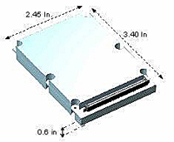The U.S. Air Force has exercised new options on contracts with three companies for development of GPS Modernized User Equipment (MUE) for future military applications.
Under the new awards, Raytheon will receive $65 million; Rockwell Collins, $50.7 million; and L-3/Interstate Electronics Corporation, $36 million. All options were awarded on or about October 19.
The U.S. Air Force has exercised new options on contracts with three companies for development of GPS Modernized User Equipment (MUE) for future military applications.
Under the new awards, Raytheon will receive $65 million; Rockwell Collins, $50.7 million; and L-3/Interstate Electronics Corporation, $36 million. All options were awarded on or about October 19.
The existing contracts were signed in mid-2006 for proof-of-concept designs of ground and airborne OEM modules: a Ground Based GPS Receiver Application Module with a Modernized Standard Serial Interface (GB-GRAM-M SSI) and a GPS Receiver Application Module Type S (GRAM-SEM-E/M) card.
Under the initial contract award IEC received nearly $37.2 million; Raytheon, about $37.8 million; and Rockwell Collins, more than $27.8 million. Additional contract options are available.
The new modernized modules are standard and backward compatible, making them useable in many GPS receiver applications. In most cases, this should eliminate the cost of developing new modules for each individual application.
L-3 says it will integrate its modules into a new line of MUE GPS receivers, using a single system-on-chip (SoC) application specific integrated circuit (ASIC). The ASIC integrates the selective availability/anti-spoofing module (SAASM), GPS P/Y- and C/A-code signal functions, and the military M-code signal tracking algorithms in a single unit.
The Department of Defense Fiscal Year 2008 appropriations bill signed into law in November allocates $156.47 million for MUE development.
A GPS Wing spokesperson at the Space and Missile Systems Center, Los Angeles Air Force Base, California, said that the wing is working closely with Office of the Secretary of Defense and the military services “to better define an official program strategy aimed at fielding M-code user equipment sooner. This requires a signed JROC [Joint Requirements Oversight Council] requirements document, a technology development plan, multiple domain (air/ground/space/munition) form factors, initial integration and test into lead service platforms, and the development of prototype user equipment.”
These activities would be followed by services’ platform integration, hardware procurement, and sustainment programs. “It is important that this strategy gets defined and budgeted before attempting to accelerate any one of the individual activities,” the GPS Wing spokesperson added.
Copyright © 2007 Gibbons Media & Research LLC, all rights reserved.





